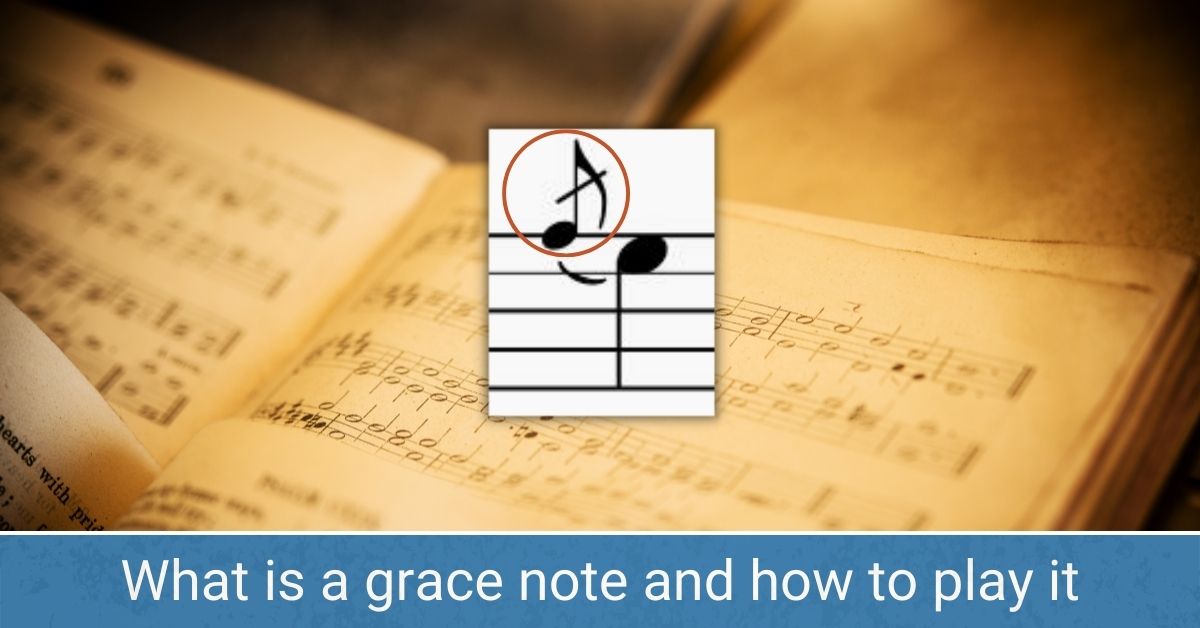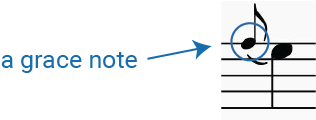Grace Notes Explained
August 25, 2021 by Taras (Terry) Babyuk
Introduction
Perhaps you've heard your teacher mention the term “grace note” during one of your lessons and even point one out to you in your sheet music, but you're still not quite sure what they are and how exactly they work. Well, one thing you should definitely know is that they are not notes that belong to a Grace! (bad joke, I know). But all joking aside, let us put on our music nerd hats and explore what these interesting-sounding notes are all about!
Grace Note Defined

A grace note is a note (or notes) used primarily for decorative purposes, such as adding interest to a musical passage. Because of this, it is usually considered non-essential (we will see an exception to this below) and omitting it does not affect the structural integrity of a musical composition. Grace notes are written smaller in size than regular notes (about 65%) and sometimes in a lighter font. A small slur often connects the grace note to the main note, but not always.
How Grace Notes are Notated in Music
Grace notes can be written with or without a connecting slur, like in the above examples.
Sometimes, you will see grace notes that look like this:
But why is the grace note crossed out in the second example, but not in the first? Great question! This is because there are two varieties of grace notes, which is our next topic of discussion.
Acciaccatura vs. Appoggiatura
The Acciaccatura (or 'crushed note')
Acciaccatura is a grace note that is played before the strong beat. The strong beat therefore belongs to the main note, which makes the acciaccatura rhythmically and melodically unimportant. Acciaccaturas are most commonly written as eighths notes (quavers) with a diagonal line going through them and a little slur connecting them to the main note.
The Appoggiatura (or 'leaning note')
Appoggiatura is a grace note that is played on the strong beat. Here, the emphasis is on the grace note as opposed to the main note, which makes the appoggiatura rhythmically and melodically important. Appoggiaturas are most often written as eighths notes (quavers) with a little slur connecting them to the main note.
How Long Do We Hold a Grace Note?
Since the appoggiatura grace note has to be given emphasis, musicians are often confused about how long it should be held. A good rule of thumb to go by is that it takes away about half the value of the main note. So in the example below, the grace note would be played as an (accented) eighth note, and the quarter note would be played as an eighth note as well.

Multiple Grace Notes
So far we have talked about grace notes consisting if just one note. And while this is quite common, grace notes can also come in twos, threes, fours, or even more notes (less common).
Two grace notes are usually written as sixteenth notes, while three and four grace notes are written as either sixteenth or thirty-second notes. Anything above four is usually shown as thirty-second notes.
* Although multiple grace notes do not have a diagonal line going through them, you should play them the same way you would play the acciaccatura. In other words, they should be unaccented and should come before the main beat.
The two-note grace note is also known as a double appoggiatura, the three-note grace note as a triple appoggiatura, and so on. But this name can be misleading, since these are almost never played on the beat, like the regular appoggiatura is. Instead, they are played in a "crushed" manner, like the acciaccatura.
Conclusion
Grace notes are a neat musical ornament and learning how to execute them correctly and effectively will make your performance that much more beautiful. You will most likely come across grace notes in the music of the Baroque and Classical periods. As music continued to change and evolve after the classical period, their use became less prevalent.
Just fill out our quick trial lesson form and wait to hear from us within 1-2 business days. If you like your trial lesson, you can sign up for regular lessons with us! Our lessons are available online (Zoom or Skype) as well as in-person if you live close to our location. Start learning your favorite instrument with one of our amazing teachers today!
